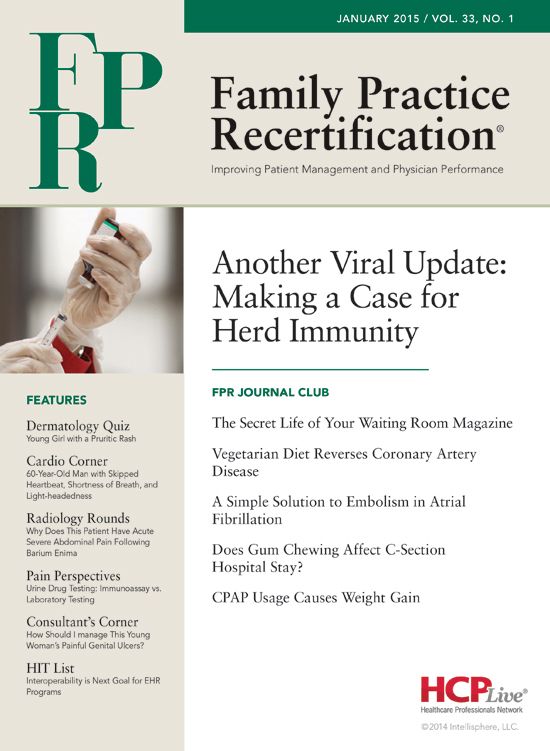Publication
Article
Family Practice Recertification
The Secret Life of Your Waiting Room Magazine
Author(s):
This observational cohort study from New Zealand found that "gossipy" magazines are often subtly taken from your waiting room, while the "non-gossipy" magazines remain.

Frank J. Domino, MD
Review
2014 Dec 11;349:g7262
An exploration of the basis for patient complaints about the oldness of magazines in practice waiting rooms: cohort study: BMJ.
This observational cohort study from New Zealand found that “gossipy” magazines are often subtly taken from your waiting room, while the “non-gossipy” magazines remain.
Study Methods, Patient Demographics, Intervention, and Control:
One general practice was used as the site for this observational study to determine which magazines are removed by patients, and which remain in the waiting area. Over the course of the study a total of 87 magazines were used.
They were stacked into 3 piles around the waiting room. Each was classified as being “non-gossipy” magazines (ie. Time magazine, the Economist, Australian Women's Weekly, National Geographic, BBC History) vs. “gossipy ones” (not identified for fear of litigation). “Gossipy” was defined as having 5 or more photographs of celebrities on the front cover; most of the gossipy magazines were found to have up to 10 such images.
Each was given a non-descriptive code on the back cover. The waiting area was evaluated twice a week for 31 days to determine:
- The rate of disappearance of magazines less than 2 months old versus magazines 3-12 months old,
- The overall rate of loss of magazines, and
3. The rate of loss of gossipy versus non-gossipy magazines.
Results & Outcomes:
At the inception of the study, 47 of the 82 magazines with a visible date on the front cover were aged less than 2 months. 28 of these 47 (60%) magazines and 10 of the 35 (29%) older magazines disappeared (P=0.002) by the end of the study. Overall, after 31 days, 41 of the original 87 magazines (47%, 95% confidence interval 37% to 58%) ultimately disappeared.
None of the 19 non-gossipy magazines had disappeared by the end of the study compared with 26 of the 27 (96%) gossipy magazines (P<0.001). Hazards ratio of gossipy magazine “death” was estimated to be 14.51 (95% CI: 6.69-33.32).
Conclusion:
Patients in a New Zealand general practice were more apt to steal gossipy magazines than non-gossipy magazines.
Commentary:
In this study, almost half of the waiting room magazines were stolen within 31 days of their arrival. Only those who had met the criteria for “gossipy”, that is had at least 5 celebrity images on the cover, were stolen, while none of the news and non-celebrity photograph based magazines disappeared.
The implications of this study are numerous. First, despite patients’ assumptions to the contrary, it is not true that doctors offices do not buy new magazines, as they are often accused. They are most likely purchasing a variety of new magazines each month.
However, the ones patients reference for their assumption about the lack of new purchases are more a case of selection bias than the fault of their doctors. This is based on their measuring the supply by what they see in the waiting room, rather than what was actually purchased.
The results of the study also imply a variety of issues concerning patients’ identity and self-conscience. While most patients would never steal a stick of chewing gum, the embarrassment of purchasing a “gossipy magazine” seems to outweigh their guilt about stealing something that belongs to someone else. While this may appear a harsh conclusion for their actions, there seems no other plausible rationale, as these magazines are readily available and not expensive.
Lastly, what is it about celebrity gossip that makes the normally judicious reader stoop to taking something that is not their own? If it is the comfort they derive from it, then does this study express some lack of empathy to their fellow patients of this practice, who may also gain relief from reading about celebrity activity? Does this reduction in values combined with a lack of empathy imply some recent degradation of society?
The good news is, likely not. The authors of this article point to the fact that in 1970 Hal Boyle, a Pulitzer Prize winning author, noted that newer magazines are often “disappeared” from doctor’s waiting rooms.
What is today’s provider to do? One suggestion was to buy only “non-gossipy” magazines for the waiting room. While this solves the loss of reading material problem, it is unlikely to meet the discerning reading needs of the anxious waiting patient. Another option is to place the gossipy magazines only in exam rooms where the sudden disappearance could be recognized and challenged by staff and physician. This could lead to a sticky confrontation with embarrassment on both sides.
The likely best solution is to continue to provide the waiting area with monthly updates in gossipy magazines, and save the expense on the non-gossipy magazines. Instead, populate the waiting area with many copies of healthy recipes, simple and fast exercise routines that encourage weight loss and a healthy lifestyle. While this may not slow the loss of the reading material, it may also promote a positive change. Dream on… I know.
Addendum: the lead author of this study, Bruce Arroll, is Professor of General Practice at and Primary Health Care, The University of Auckland, New Zealand and contributor the Cochrane Collaboration’s “PEARLS: Practice Evidence About Real Life Situations” monthly column.
About the Author
Frank J. Domino, MD, is Professor and Pre-Doctoral Education Director for the Department of Family Medicine and Community Health at the University of Massachusetts Medical School in Worcester, MA. Domino is Editor-in-Chief of the 5-Minute Clinical Consult series (Lippincott Williams & Wilkins).
Additionally, he is Co-Author and Editor of the Epocrates LAB database, and author and editor to the MedPearls smartphone app. He presents nationally for the American Academy of Family Medicine and serves as the Family Physician Representative to the Harvard Medical School’s Continuing Education Committee.




